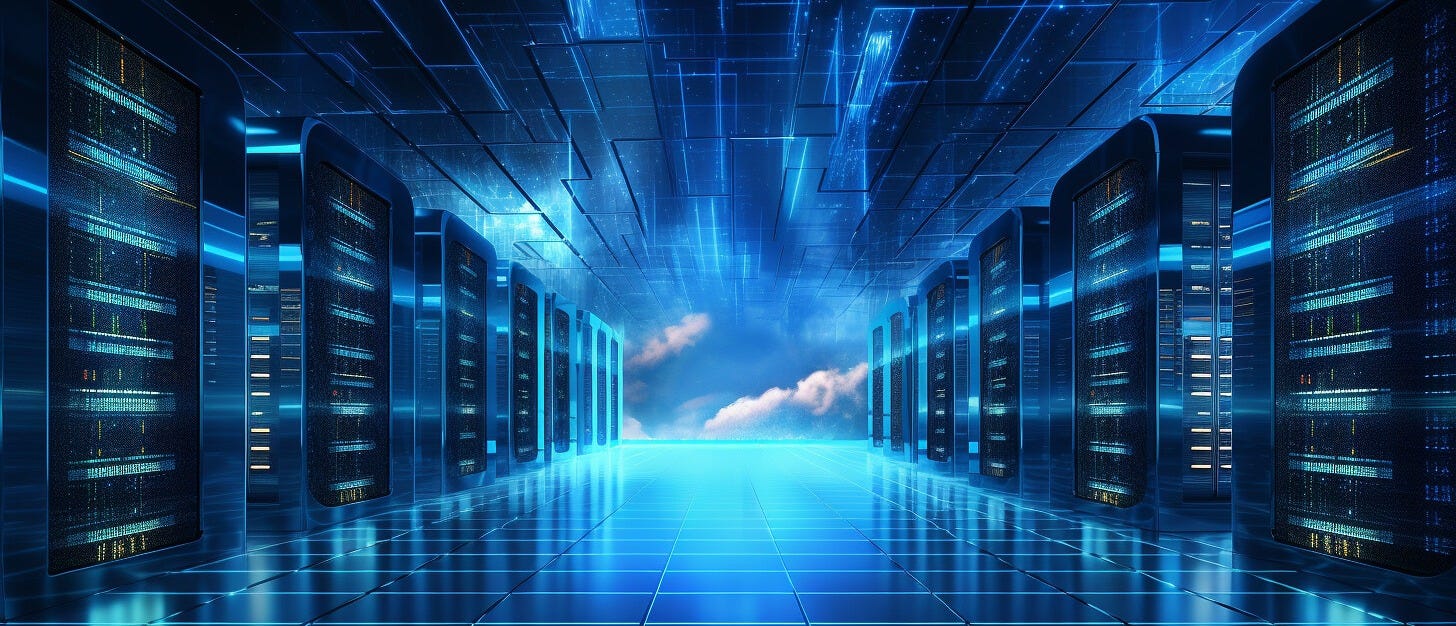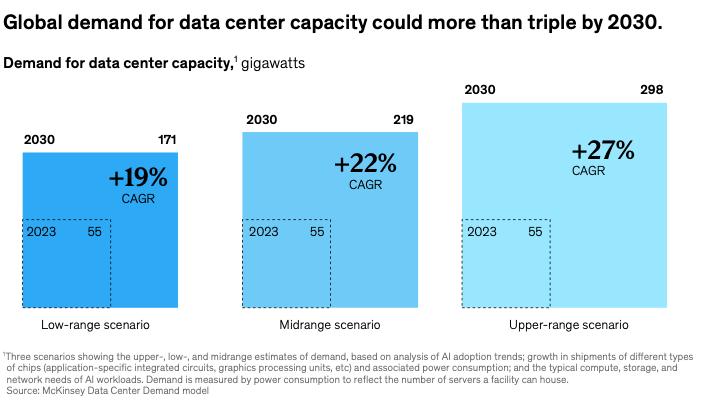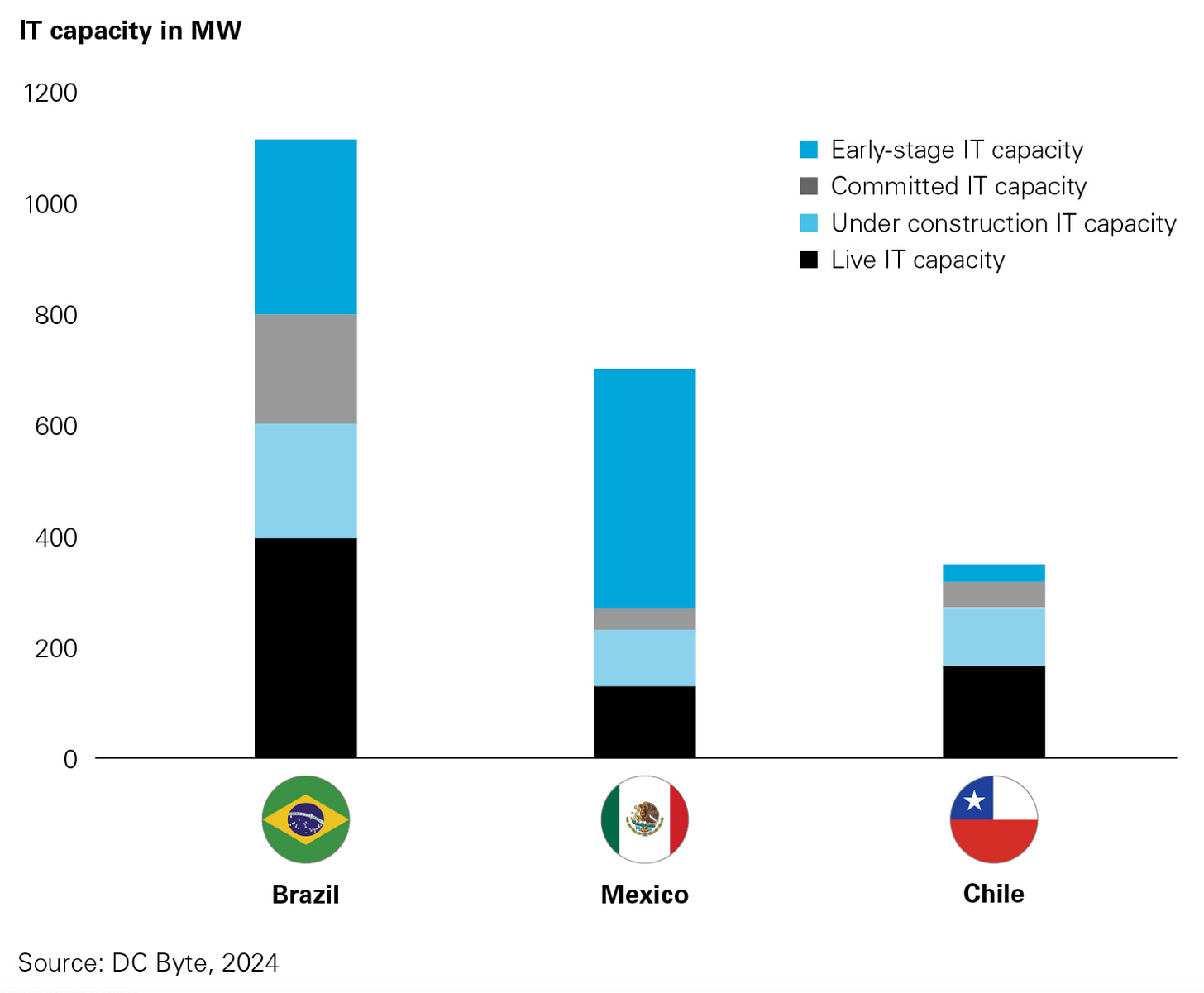Powering the Future: The Energy Challenge for Data Centers
Data centers power the digital economy but face challenges in energy demand, sustainability, and infrastructure. Innovative solutions are needed to ensure their expansion aligns with climate goals
The Energy Challenge: Powering the Digital Future
The rapid growth of data centers, driven by increasing demand from AI, cloud computing, and digital services, poses significant challenges related to energy consumption, sustainability, and infrastructure.
Energy Demand and Grid Pressure: Data centers are energy-intensive, with demand projected to nearly triple by 2030 (KKR, 2024). AI workloads alone contribute to unprecedented energy requirements. In major markets, data centers account for 30–40% of net new energy demand, straining existing grid infrastructure.
Power Availability and Lead Times: Limited availability of reliable power, especially in regions with underdeveloped grids, results in delays of over three years to power new data centers. Interconnection challenges with transmission grids exacerbate power shortages, rather than a lack of generation capacity.
Sustainability Challenges: Data centers must align with 24/7 carbon-free energy goals by 2030, but most grid decarbonization efforts lag behind these timelines. Cooling systems consume up to 40% of data center energy, contributing to inefficiencies. Water usage is also a growing concern, particularly in water-scarce regions.
Geographical Constraints: Urban areas with stable power are preferred, but as demand rises, expansion into less-developed regions creates logistical challenges for power access and grid connectivity.
Economic and Environmental Risks: Rising operational costs due to reliance on fossil fuels and grid instability make sustainable solutions critical. Power outages expose operators to legal and financial risks due to service-level breaches.
Market Overview
The rise of generative AI (Gen AI) is driving an even greater surge in data center demand. From 2023 to 2030, global data center capacity is expected to grow at an annual rate of 19–22%, reaching between 171 and 219 gigawatts (GW). Despite this expansion, the U.S. alone could face a supply gap exceeding 15 GW by 2030. In a midrange scenario, AI-ready data center capacity is projected to increase by an average of 33% per year over the same period.
Data centers are rapidly becoming one of the most dynamic asset classes in commercial real estate, particularly in emerging markets. Much of this expansion is now focused on “secondary markets” like Latin America, where major data center operators are projected to invest over US$2 billion in 2024 alone. This growth is being driven by the increasing reliance on cloud computing in the digital economy, along with data localization requirements and the rise of “proximity sourcing” to the U.S.
As a result, the construction of data centers in Mexico and other Latin American nations has surged significantly. The Latin American data center market is anticipated to double within the next five years, growing from an estimated US$5–6 billion in 2023 to US$8–10 billion by 2029.
Recently, Amazon Web Services (AWS) has announced a $5 billion investment to establish a new server region in Mexico, aiming to enhance cloud services across Latin America. The initiative includes constructing a digital hub in Querétaro, offering over 440 high-tech services such as cloud computing, data storage, and artificial intelligence projects. This development is expected to contribute more than $10 billion to Mexico’s GDP over the next 15 years and create approximately 7,000 jobs annually. AWS plans to train over 200,000 individuals to support this digital center. Querétaro was selected for its strategic location, talent availability, and services. This announcement aligns with the Mexican government’s strategy to attract investments and promote “nearshoring” opportunities
Greener Data Centers: Unlocking Sustainable Growth
Sustainability and efficiency are now critical for the future of data centers. Innovative solutions like renewable energy, residual energy use, and advanced cooling are key to meeting demand while reducing environmental impact.
1. Residual Energy Solutions
Leveraging wasted energy (e.g., flared gas, landfill methane) to power data centers. Immediate ROI potential by converting otherwise wasted energy into usable power, reducing greenhouse gas emissions.
Relevance in LatAm
Flared gas and methane from landfills are underutilized in many LatAm countries, creating an untapped opportunity to turn waste into energy.
LatAm’s grid infrastructure, particularly in rural areas, often struggles with reliability, creating demand for independent power systems.
High growth in secondary and edge data centers increases the need for decentralized energy solutions
2. Energy Efficiency SaaS for Data Centers
SaaS platforms designed to optimize energy usage and cooling efficiency in data centers offer a scalable and impactful solution to the sector’s growing energy challenges. These tools leverage real-time monitoring, AI-driven analytics, and automation to reduce energy consumption, improve operational efficiency, and help data centers meet sustainability goals.
Relevance in LatAm
High Growth and Challenges: Rapid data center expansion in cities like São Paulo and Santiago, combined with energy and cooling inefficiencies, creates a need for optimization solutions.
Sustainability Pressure: Government mandates and water scarcity in regions like northern Mexico and central Chile drive demand for energy- and water-efficient technologies.
3. Renewable Energy Integration
Scaling renewable energy sources, such as geothermal and small modular reactors (SMRs), for data centers. Hyperscalers and co-locators are aggressively investing in carbon-free energy, creating opportunities for innovative, scalable solutions.
Relevance in LatAm
Abundant renewable energy resources, particularly wind, solar, and hydroelectric power
Countries like Brazil and Chile have strong commitments to renewable energy, offering favorable regulatory frameworks for clean energy.
4. Advanced Cooling Technologies
Innovations in liquid cooling, immersion cooling, and waste heat reuse to improve energy efficiency. Cooling accounts for ~40% of non-hyperscaler energy use, with efficiency gains directly impacting operating costs.
Relevance in LatAm
High temperatures in many parts of LatAm increase energy demands for cooling systems, making efficient cooling critical for sustainability and cost management.
Water scarcity in regions like northern Mexico and central Chile heightens the need for water-efficient cooling solutions.
DeepSeek Shakes Up AI: What It Means for Data Centers and the Future of AI Infrastructure?
This week, DeepSeek, a groundbreaking Chinese AI model, sent shockwaves across the AI world. Known for its unparalleled efficiency and affordability, DeepSeek has demonstrated the ability to perform complex AI tasks at a fraction of the computational cost compared to existing U.S.-developed models. Its emergence has disrupted the market, causing stock prices of AI-related companies—ranging from SaaS providers to chip manufacturers and energy suppliers—to tumble, as investors grapple with what this innovation means for the competitive landscape.
The arrival of DeepSeek raises critical questions about the future of AI value/costs, infrastructure spending. If AI technology becomes significantly cheaper and more efficient, the demand for high-density, power-intensive data centers could shift, potentially leading to reduced pressure on AI infrastructure budgets. However, this affordability also makes AI technology more accessible, driving broader adoption across industries and creating an even greater need for data center deployment.
Jevons Paradox, posits that improvements in the efficiency of resource use can lead to an overall increase in consumption of that resource. This concept has been invoked in discussions about DeepSeek, where Microsoft CEO Satya Nadella referenced Jevons Paradox, suggesting that as AI becomes more efficient and accessible, its utilization will surge, potentially increasing the demand for computing resources. Analysts believe that while DeepSeek’s advancements may reduce individual AI development costs, the resulting proliferation of AI applications could lead to greater overall consumption of computing power.
While uncertainty remains about the trajectory of AI infrastructure spending, one thing is clear: the expansion of data centers will continue to be essential to meet the growing demands of AI and other digital services. This creates a massive opportunity for companies involved in data center technologies, renewable energy integration, cooling systems, and energy efficiency solutions to capitalize on the evolving market dynamics.







